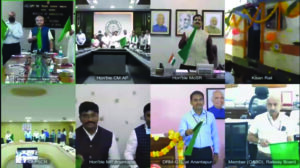AMARAVATI, SEP 9
Aiming to connect the farms to the agricultural markets, the first ”Kisan Rail” from south India chugged off from Anantapuramu in Andhra Pradesh on Wednesday carrying 322 tonnes of fresh fruits to the famous Azadpur Mandi in the national Capital. Union Minister for Agriculture Narendra Singh Tomar and Andhra Pradesh Chief Minister Y S Jagan Mohan Reddy flagged off the inaugural Kisan Rail, the second in the country, via a video link from New Delhi and Amaravati.

This train, loaded with 14 parcel vans, will cover a distance of 2150 kms in 40 hours. Union Minister of State for Railways Suresh Angadi, Anantapuramu MP T Rangaiah, South Central Railway General Manager Gajanan Mallya, Anantapuramu district Collector Gandham Chandrudu, Guntakal Railway Division Manager Alok Tiwari and others joined the event.
The Kisan Rail comes as a boon to farmers, particularly those growing horticultural crops, as it ensures the produce reaches the markets in quicker time.
“In Anantapuramu, fruits and vegetables are being grown in more than 2 lakh hectare area, and the Kisan Rail will prove very beneficial to farmers of this region. Kisan Udaan service will also be started soon,” Tomar said at the inaugural event.
On August 7, the first Kisan Rail was flagged off between Devlali in Maharashtra and Danapur in Bihar as a weekly service, which was later made bi-weekly due to increasing demand. Now the second Kisan Rail will benefit farmers of the states coming en route, he said. Kisan Rail and Kisan Udaan had been announced in this year’s budget so that farm produce is able to be transported all over the country in less time, an official statement quoted Tomar as having said in the virtual event.
Tomar also appreciated the implementation of the new agriculture ordinances and the Rs 1 lakh crore Agri Infrastructure Fund in Andhra Pradesh. Noting that horticulture was an important activity in the state, the Andhra Pradesh Chief Minister said the state ranks first in the country in the production of tomatoes, coconut, papaya and chillies and is the biggest fruit producing state in South India. “During the Covid-19 situation, transportation of this horticultural produce to North India had become difficult.
A number of special trains were run from Anantapuramu to Mumbai during the lockdown so that the horticultural produce could reach other parts of the country,” he said. Union Minister of State for Railways said Kisan Rail is being started to help in the speedy transportation of farm produce to distant places, in keeping with the goal of doubling farmers” income.
“Farmers can now sell their produce wherever they get a better price without spoilage due to reduction in transportation time. This facility will also help in increasing agricultural exports,” he added.
In the existing system of transportation through trucks, post-harvest losses of about 25 per cent were causing a loss of about Rs 300 crore a year to the farmers. “We can now eliminate this as shipment through train will keep the product intact and fetch a premium price. Besides erasing the loss of Rs 300 crore (due to transportation damages), farmers can also stand to gain Rs 400 crore per annum by realising a premium price on their produce,” he noted.
Though otherwise a parched district, Anantapuramu is considered the ”fruit bowl of Andhra Pradesh,” where the cropped area under horticulture is 2.02 lakh hectares, yielding an output of 58.39 lakh tonnes per annum of various fruits and vegetables.
While consumption of fruits and vegetables within the state is only around six lakh tonnes, the rest is marketed across the country and abroad. “Sweet orange, banana, mango, papaya, pomegranate and melons are our major produce that have a good market in Delhi, Rajasthan, Madhya Pradesh, Goa, Tamil Nadu, Haryana, UP, West Bengal, Gujarat and Karnataka.
Our tomato, grapes, pomegranate, sweet orange and banana are exported to Bangladesh, Nepal and Middle East countries,” Chandrudu said. The Kisan Rail is planned to be run once a week now but as harvesting picks up after October, the frequency may be increased from January based on the demand.












